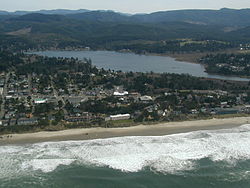| Devils Lake | |
|---|---|
 The lake from D River | |
| Location | Lincoln County, Oregon |
| Coordinates | 44°58′57″N 123°59′32″W / 44.9824095°N 123.9921317°W[1] |
| Lake type | eutrophic |
| Primary inflows | Rock Creek, Thompson Creek |
| Primary outflows | D River |
| Catchment area | 12 sq mi (31 km2) |
| Basin countries | United States |
| Max. length | 3 mi (4.8 km) |
| Max. width | 0.75 mi (1.21 km) |
| Surface area | 680 acres (280 ha) |
| Average depth | 8.4 ft (2.6 m) |
| Max. depth | 21.1 ft (6.4 m) |
| Water volume | 5,750 acre⋅ft (7,090,000 m3) |
| Residence time | 0.15 years |
| Surface elevation | 10.4 ft (3.2 m) |
| Settlements | Lincoln City |

Devils Lake is a small lake in Lincoln County, Oregon, United States, along the Oregon Coast.[1] It separates the northern part of Lincoln City from the Central Oregon Coast Range. It is 1/3 of a mile wide, three miles (5 km) long, and up to 21 feet (6.4 m) deep. The D River flows from the lake westward to the Pacific Ocean. At 120 feet (37 m), it once contested with the Roe River in Montana for the title of the "World's Shortest River", until in 2006 the heated debates and technicalities caused the Guinness World Records to no longer recognize the accolade.
According to Oregon Geographic Names, the name derives from a Native American legend. In the legend, a giant fish, giant octopus, or other large marine creature would occasionally surface, much to the dismay of anyone fishing in the vicinity.
The lake is managed by the Devils Lake Water Improvement District. The Preservation Association of Devils Lake (PADL) was founded in 1982. According to the organization's website, its mission is:
To correct, protect and preserve the water resources and other natural assets of Devils Lake from misuse and pollution. To encourage the improvement of the overall environmental and economic use of the lake as a recreational, scenic asset for all time to the entire Lincoln City area.
- ^ a b "Devils Lake". Geographic Names Information System. United States Geological Survey, United States Department of the Interior. Retrieved Jan 16, 2021.

